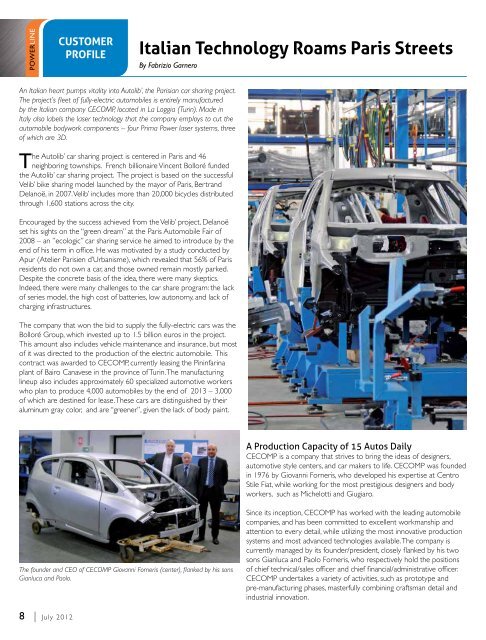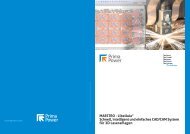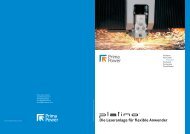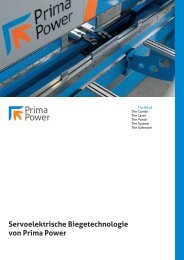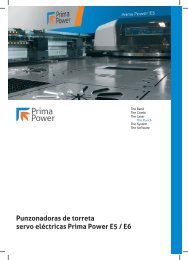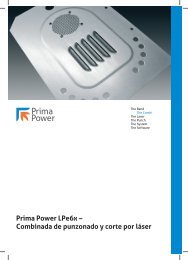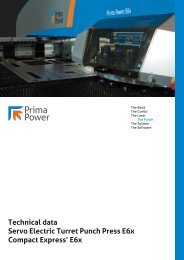customer profile - Prima Power
customer profile - Prima Power
customer profile - Prima Power
You also want an ePaper? Increase the reach of your titles
YUMPU automatically turns print PDFs into web optimized ePapers that Google loves.
POWERLINE<br />
8 July 2012<br />
CUSTOMER<br />
PROFILE<br />
An Italian heart pumps vitality into Autolib’, the Parisian car sharing project.<br />
The project’s fleet of fully-electric automobiles is entirely manufactured<br />
by the Italian company CECOMP, located in La Loggia (Turin). Made in<br />
Italy also labels the laser technology that the company employs to cut the<br />
automobile bodywork components -- four <strong>Prima</strong> <strong>Power</strong> laser systems, three<br />
of which are 3D.<br />
The Autolib’ car sharing project is centered in Paris and 46<br />
neighboring townships. French billionaire Vincent Bolloré funded<br />
the Autolib’ car sharing project. The project is based on the successful<br />
Velib’ bike sharing model launched by the mayor of Paris, Bertrand<br />
Delanoë, in 2007. Velib’ includes more than 20,000 bicycles distributed<br />
through 1,600 stations across the city.<br />
Encouraged by the success achieved from the Velib’ project, Delanoë<br />
set his sights on the “green dream” at the Paris Automobile Fair of<br />
2008 – an ”ecologic” car sharing service he aimed to introduce by the<br />
end of his term in office. He was motivated by a study conducted by<br />
Apur (Atelier Parisien d’Urbanisme), which revealed that 56% of Paris<br />
residents do not own a car, and those owned remain mostly parked.<br />
Despite the concrete basis of the idea, there were many skeptics.<br />
Indeed, there were many challenges to the car share program: the lack<br />
of series model, the high cost of batteries, low autonomy, and lack of<br />
charging infrastructures.<br />
The company that won the bid to supply the fully-electric cars was the<br />
Bolloré Group, which invested up to 1.5 billion euros in the project.<br />
This amount also includes vehicle maintenance and insurance, but most<br />
of it was directed to the production of the electric automobile. This<br />
contract was awarded to CECOMP, currently leasing the Pininfarina<br />
plant of Bairo Canavese in the province of Turin. The manufacturing<br />
lineup also includes approximately 60 specialized automotive workers<br />
who plan to produce 4,000 automobiles by the end of 2013 – 3,000<br />
of which are destined for lease. These cars are distinguished by their<br />
aluminum gray color, and are “greener”, given the lack of body paint.<br />
Italian Technology Roams Paris Streets<br />
By Fabrizio Garnero<br />
The founder and CEO of CECOMP Giovanni Forneris (center), flanked by his sons<br />
Gianluca and Paolo.<br />
A Production Capacity of 15 Autos Daily<br />
CECOMP is a company that strives to bring the ideas of designers,<br />
automotive style centers, and car makers to life. CECOMP was founded<br />
in 1976 by Giovanni Forneris, who developed his expertise at Centro<br />
Stile Fiat, while working for the most prestigious designers and body<br />
workers, such as Michelotti and Giugiaro.<br />
Since its inception, CECOMP has worked with the leading automobile<br />
companies, and has been committed to excellent workmanship and<br />
attention to every detail, while utilizing the most innovative production<br />
systems and most advanced technologies available. The company is<br />
currently managed by its founder/president, closely flanked by his two<br />
sons Gianluca and Paolo Forneris, who respectively hold the positions<br />
of chief technical/sales officer and chief financial/administrative officer.<br />
CECOMP undertakes a variety of activities, such as prototype and<br />
pre-manufacturing phases, masterfully combining craftsman detail and<br />
industrial innovation.
CECOMP has fully embraced the project of the Bolloré group, going<br />
beyond the design and prototype phases of the electric automobile<br />
to take on the role of bodywork producer and manufacturer of the<br />
entire vehicle. Currently CECOMP is fully involved in producing the<br />
bodywork and assembling and detailing the cars, 15 of which are<br />
completed daily. “Reaching this productive capacity required us to seek<br />
a solution that allowed us to reach and maintain this quota since we<br />
are not car makers,” recounts Paolo Forneris, CECOMP CEO. “The<br />
Pininfarina production plant of Bairo Canavese was the perfect solution<br />
for us. Each day our 15 cars utilize only one assembly station out of<br />
three. Despite this, having the assembly line already set up, with only a<br />
few changes for electric vehicle production, as opposed to Pininfarina’s<br />
internal combustion engine models, was essential.”<br />
High-Strength Steel and Aluminum is a Matter of<br />
Weight<br />
“Thinking about the car production cycle,” continues Paolo Forneris,<br />
“we started from the bottom up…which means from assembly to the<br />
finishing line. The job began back on October 2009 for us, and we gave<br />
way to the manufacturing process of the first vehicles after only two<br />
months, once the design was approved. We delivered the first cars in<br />
July of last year. In only 18 months, we were able to start manufacturing<br />
our automobiles with all the required approvals. Vehicle standardization<br />
is the same as for large series, but with a limit on the amount that can<br />
be manufactured. CECOMP can produce 1,000 vehicles per year.”<br />
CECOMP preferred laser cutting flexibility to traditional sheet punching.<br />
CECOMP followed the “style” of the electric vehicle that Pinifarina<br />
had begun to study for the Bolloré Group, which is the head of the<br />
consortium that was awarded the contract. “This is a four-passenger,<br />
two-door vehicle that is 3.65 meters long and weighs 1,100 kg. In<br />
comparison to the original, its interiors were re-conceived to limit<br />
production costs”, continues company CEO, Paolo Forneris.<br />
The Flexibility of Laser Cutting Instead of Traditional<br />
Punching<br />
“When starting production, we first made the prototypes and then<br />
the pre-series, putting together all bodywork punching and assembly<br />
equipment in-house. We were dealing with small quantities when<br />
compared with traditional car making, so we opted for what we<br />
considered the right production compromise.”<br />
The Rapido Evoluzione system by <strong>Prima</strong> <strong>Power</strong> installed at CECOMP.<br />
CECOMP preferred laser cutting flexibility to traditional punching. The<br />
sections of shaped sheet metal and dies were cut using four <strong>Prima</strong> <strong>Power</strong><br />
lasers that consisted of one Optimo and two Rapido – one of which is<br />
the more recent Rapido Evoluzione model – and a Platino 2D system.<br />
3D Laser Cutting is Essential<br />
“We already owned two <strong>Prima</strong> <strong>Power</strong> laser machines for 3D cutting<br />
(Optimo and Rapido), one from 2006 and the other from the following<br />
year,” says Paolo Forneris. “But the Autolib’ project motivated us to<br />
purchase a new flat cutting system in 2010. We procured the Platino,<br />
used to cut sheet metal shapes, followed by the Rapido Evoluzione last<br />
July, which is a latest generation system that allowed us to organize our<br />
machinery for any production requirements at issue.”<br />
There are a total of over<br />
300 product codes to cut,<br />
among parts in aluminum and<br />
other elements that make<br />
up the vehicle, for a total of<br />
10 work hours per vehicle.<br />
The noteworthy savings<br />
of time and the variation<br />
of pieces once again justify<br />
laser production technology.<br />
Currently, CECOMP is one<br />
of the few companies in<br />
Italy tooled to face this type<br />
of production, thanks to its<br />
large and well-equipped<br />
fabrication and laser cutting<br />
shops, even though laser<br />
technology was initially<br />
conceived more for the<br />
manufacture of prototypes. It<br />
is important to keep in mind<br />
that CECOMP started off<br />
as a model maker, and that<br />
the first <strong>Prima</strong> <strong>Power</strong> laser – at<br />
Nitrogen cutting of aluminum leaves the<br />
piece clean, and this is extremely important<br />
since the vehicle is not painted.<br />
Continued on page 10<br />
PRIMAPOWER.COM 9
POWERLINE<br />
Continued from page 9<br />
CUSTOMER<br />
PROFILE<br />
the time known as <strong>Prima</strong> Industrie – was installed because a flexible<br />
prototype cutting method was required, “We cut from 10 to 150/200<br />
pieces per batch in relation to each <strong>customer</strong>’s needs,” states Forneris.<br />
Today, laser tech is a fundamental plus for the production of this<br />
electric car, but also important in other scenarios. “Having both cuttingedge<br />
laser technology and a fabrication shop positions us to meet all<br />
our needs,” says Forneris. “Whether we use laser cutting or dies and<br />
presses depends on the target quantity. Our electric car is an example<br />
because 3,000 units do not justify the use of punching dies. Therefore,<br />
let’s leave room for lasers that have been extremely instrumental for<br />
this production, with emphasis on the 3D cutting plant. Without this<br />
technology, embarking on this journey would have been impossible”.<br />
Four Complementary Lasers From Different Eras.<br />
Though conceptually the same, in just a few years laser technology<br />
has undergone significant advancement to instill a different cutting<br />
approach to cars produced by a single manufacturer, and, at times, also<br />
affects a single series. This holds true for CECOMP, that operates three<br />
3D laser systems – purchased over the course of several years-- and<br />
the company considers them complementary in all processes. The<br />
component positioning equipment was designed to be “universal” and<br />
can be employed in each of the three systems. This makes it possible to<br />
overcome any difficulty, even downtime due to scheduled maintenance,<br />
given the importance of production timetables.<br />
“Even if a machine is idle, we are still able to produce the codes and<br />
quantities required to produce 15 vehicles daily, simply by optimizing<br />
the cutting parameters due to a difference of laser power rating of<br />
the systems... and not to the fact that the machines are equipped<br />
with different CNC systems,” says Antonio Bellini, <strong>Prima</strong> <strong>Power</strong> area<br />
manager, the contact for CECOMP on all laser- related issues. “This<br />
is a fundamental aspect for CECOMP in view of continuity, allowing<br />
<strong>customer</strong>s to use the same programs and technology regardless of the<br />
machine model, CNC system or year of purchase.”<br />
“Obviously a series of item dimensional checks and inspections is<br />
performed when any piece being cut is moved from one machine to<br />
the other,” points out Forneris. “The majority of elements can switch<br />
machines, while some can only be cut using Optimo for reasons of size,<br />
such as the side panels.”<br />
CECOMP has implemented the Tebis cutting machine control module<br />
to program its laser machines, after using the specific software in its<br />
plants to eliminate burring. “There is a choice made in consideration<br />
of simplicity and continuity since they already have a good knowledge<br />
of the Tebis milling software. This is a tribute to the <strong>Prima</strong> <strong>Power</strong><br />
machines that have proven to be extremely flexible and open to<br />
any CAM cutting control software on the market,” says Bellini. “The<br />
machines are equipped with high-power laser generators: 3,000 W<br />
for <strong>Prima</strong> Rapido and 4,000 W for Platino and Rapido Evoluzione, the<br />
latter requiring high-power concentrations, as they are mostly used<br />
to cut aluminum nitride. Aluminum cutting called for particular care<br />
and attention to cutting-parameter tuning to prevent burring usually<br />
generated by this material.”<br />
10 July 2012<br />
<strong>Prima</strong> <strong>Power</strong> cutting systems are extremely flexible and reliable.<br />
“In regards to machine hardware, a calcium-based powder metering<br />
system was mounted to spray the coating into the evacuation pipe to<br />
douse the potential flammability of aluminum powder. Furthermore,<br />
employing almost exclusively nitrogen gas used for sheet metal cutting,<br />
CECOMP also disposes of large cryogenic tanks that provide the<br />
amount of nitrogen required to cover three cutting shifts on four<br />
machines. Nitrogen cutting of aluminum leaves the piece clean (the<br />
cutting residue is in the form of a powder easily brushed away by hand),<br />
and this is extremely important since the vehicle is not painted.”<br />
A Replicable and Repeatable Project?<br />
Can the Autolib’ project be reproduced in other world cities and<br />
capitals? “That is what we hope,” answers company CEO Mr. Forneris.<br />
“Aside from mere profits, I personally find that this has been a<br />
fascinating experience up to this point. In addition, this is the first time<br />
we have produced a vehicle off the drawing board. Currently, CECOMP<br />
has a specific mandate to manufacture 3,000 electric cars by December<br />
13, the date in which the contract expires.”<br />
This is a translated and edited version of an article that<br />
appeared in Deformazione Issue # 185, May 2012.


